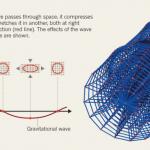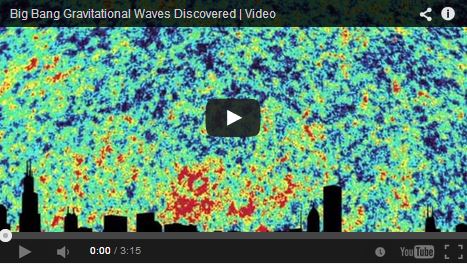Telescope Captures Peek at 'The Beginning of Everything'

See also this accompanying video -- moderator.
Astronomers have peered back to nearly the dawn of time and found what seems to be the long-sought ‘smoking gun’ for the theory that the Universe underwent a spurt of wrenching, exponential growth called inflation during the first tiny fraction of a second of its existence.
Using a radio telescope at the South Pole, the US-led team has detected the first evidence of primordial gravitational waves, ripples in space that inflation generated 13.8 billion years ago when the Universe first started to expand.
The telescope captured a snapshot of the waves as they continued to ripple through the Universe some 380,000 years later, when stars had not yet formed and matter was still scattered across space as a broth of plasma. The image was seen in the cosmic microwave background (CMB), the glow that radiated from that white-hot plasma and that over billions of years of cosmic expansion has cooled to microwave energies.
The fact that inflation, a quantum phenomenon, produced gravitational waves demonstrates that gravity has a quantum nature just like the other known fundamental forces of nature, experts say. Moreover, it provides a window into interactions much more energetic than are accessible in any laboratory experiment. In addition, the way that the team confirmed inflation is itself of major significance: it is the most direct evidence yet that gravitational waves — a key but elusive prediction of Albert Einstein’s general theory of relativity — exist.
“This is a totally new, independent piece of cosmological evidence that the inflationary picture fits together,” says theoretical physicist Alan Guth of the Massachusetts Institute of Technology (MIT) in Cambridge, who proposed the idea of inflation in 1980. He adds that the study is “definitely” worthy of a Nobel prize.
Instant inflation
Guth’s idea was that the cosmos expanded at an exponential rate for a few tens of trillionths of trillionths of trillionths of seconds after the Big Bang, ballooning from subatomic to football size. Inflation solves several long-standing cosmic conundrums, such as why the observable Universe appears uniform from one end to the other. Although the theory has proved to be consistent with all cosmological data collected so far, conclusive evidence for it has been lacking.
Cosmologists knew, however, that inflation would have a distinctive signature: the brief but violent period of expansion would have generated gravitational waves, which compress space in one direction while stretching it along another (see 'Ripple effect'). Although the primordial waves would still be propagating across the Universe, they would now be too feeble to detect directly. But they would have left a distinctive mark in the CMB: they would have polarized the radiation in a curly, vortex-like pattern known as the B mode (see 'Cosmic curl').

Last year, another telescope in Antarctica — the South Pole Telescope (SPT) — became the first observatory to detect a B-mode polarization in the CMB (see Nature http://doi.org/rwt; 2013). That signal, however, was over angular scales of less than one degree (about twice the apparent size of the Moon in the sky), and was attributed to how galaxies in the foreground curve the space through which the CMB travels (D. Hanson et al. Phys. Rev. Lett. 111, 141301; 2013). But the signal from primordial gravitational waves is expected to peak at angular scales between one and five degrees.
And that is exactly what John Kovac of the Harvard-Smithsonian Center for Astrophysics (CfA) in Cambridge, Massachusetts, and his colleagues now say they have detected, using an instrument dubbed BICEP2 that is located just metres away from its competitor, the SPT.
Detecting the tiny B mode required measuring the CMB with a precision of one ten-millionth of a kelvin and distinguishing the primordial effect from other possible sources, such as galactic dust.
“The key question,” says Daniel Eisenstein, an astrophysicist at the CfA, “is whether there could be a foreground that masquerades like this signal”. But the team has all but ruled out that possibility, he says. First, the researchers were careful to point BICEP2 — an array of 512 superconducting microwave detectors — at the Southern Hole, a patch of sky that is known to contain only tiny amounts of such emissions. They also compared their data with those taken by an earlier experiment, BICEP1, and showed that a dust-generated signal would have had a different colour and spectrum.
Furthermore, data taken with a newer, more sensitive polarization experiment, the Keck array, which the team finished installing at the South Pole in 2012 and will continue operating for two more years, showed the same characteristics. “To see this same signal emerge from two other, different telescopes was for us very convincing,” says Kovac.
“The details have to be worked out, but from what I know it’s highly likely this is what we’ve all been waiting for,” says astronomer John Carlstrom of the University of Chicago, Illinois, who is the lead researcher on the SPT. “This is the discovery of inflationary gravitational waves.”

Solid signature
Cosmologist Marc Kamionkowski adds: “To me, this looks really, really solid.” He was one of the first cosmologists to calculate what the signature of primordial gravitational waves should look like in the CMB. The findings are “on a par with dark energy, or the discovery of the CMB — something that happens once every several decades”, says Kamionkowski, who is at Johns Hopkins University in Baltimore, Maryland.
The strength of the signal measured by BICEP2, although entirely consistent with inflation, initially surprised the researchers because it is nearly twice as large as estimated from previous experiments. According to theory, the intensity of a B-mode signal reveals how fast the Universe expanded during inflation, and therefore suggests the energy scale of the cosmos during that epoch. The data pinpoint the time when inflation occurred — about 10–37 seconds into the Universe’s life — and its temperature at the time, corresponding to energies of about 1016 gigaelectronvolts, says cosmologist Michael Turner of the University of Chicago. That is the same energy at which three of the four fundamental forces of nature — the weak, strong and electromagnetic force — are expected to become indistinguishable from one another in a model known as the grand unified theory.
Because inflation took place in the realm of quantum physics, seeing gravitational waves arise from that epoch provides “the first-ever experimental evidence for quantum gravity”, says MIT cosmologist Max Tegmark — in other words, it shows that gravity is at heart a quantum phenomenon, just like the other three fundamental forces. Physicists, however, have yet to fully understand how to reconcile general relativity with quantum physics from a theory standpoint.
The researchers reported the findings on 17 March at a press briefing at the CfA, held just after they described their results to scientists in a technical talk. The team also released several papers describing the results. In so doing, it seems to have beaten the SPT and also several other groups racing to find the fingerprint of inflation using an assortment of balloon-borne and ground-based experiments and one satellite, the European Space Agency’s Planck spacecraft.
More-extensive maps of the B-mode polarization, and especially a full-sky survey, which the Planck telescope may be able to obtain later this year, should provide more clues about how inflation unfolded and what drove it. In addition to looking farther back in time than ever before, the discovery “is opening a window a trillion times higher in energy than we can access with the Large Hadron Collider”, the world’s premiere atom smasher, notes cosmologist Avi Loeb of the CfA, who is not part of the BICEP2 team.
Nature 507, 281–283 (20 March 2014) doi:10.1038/507281a

